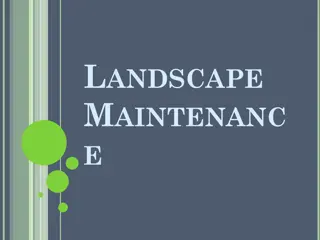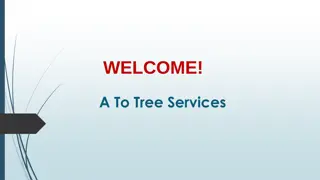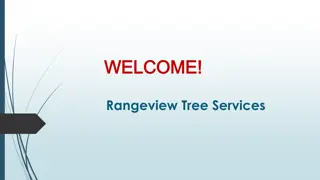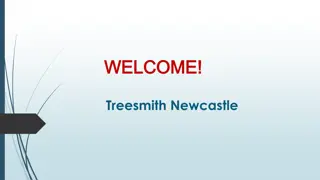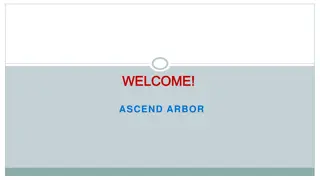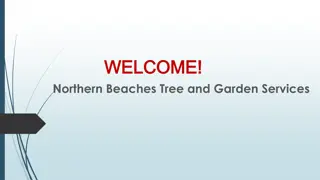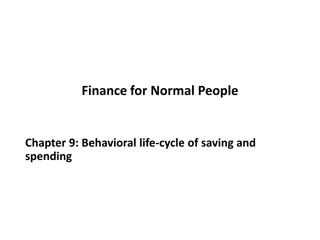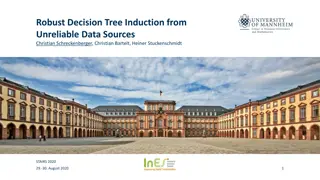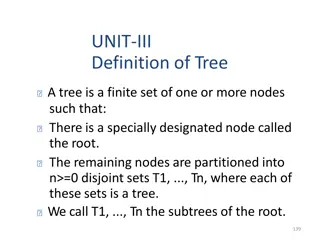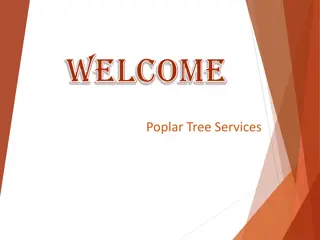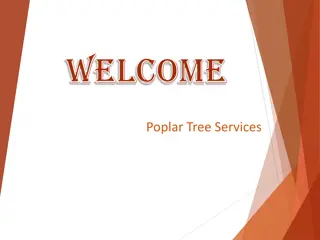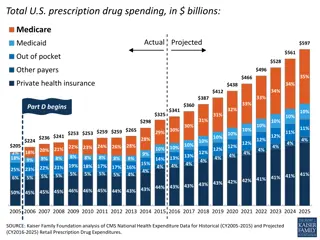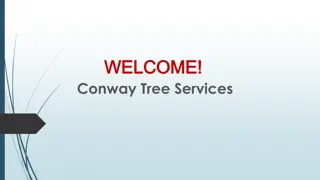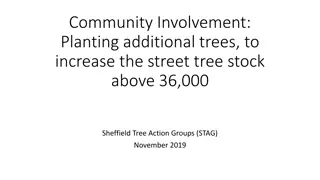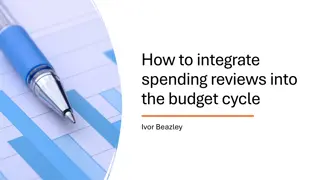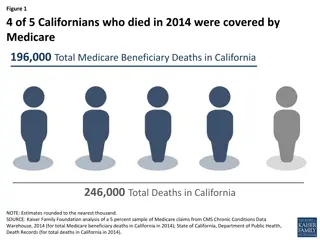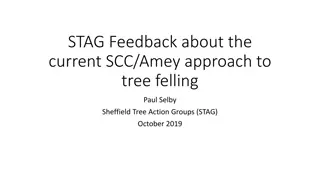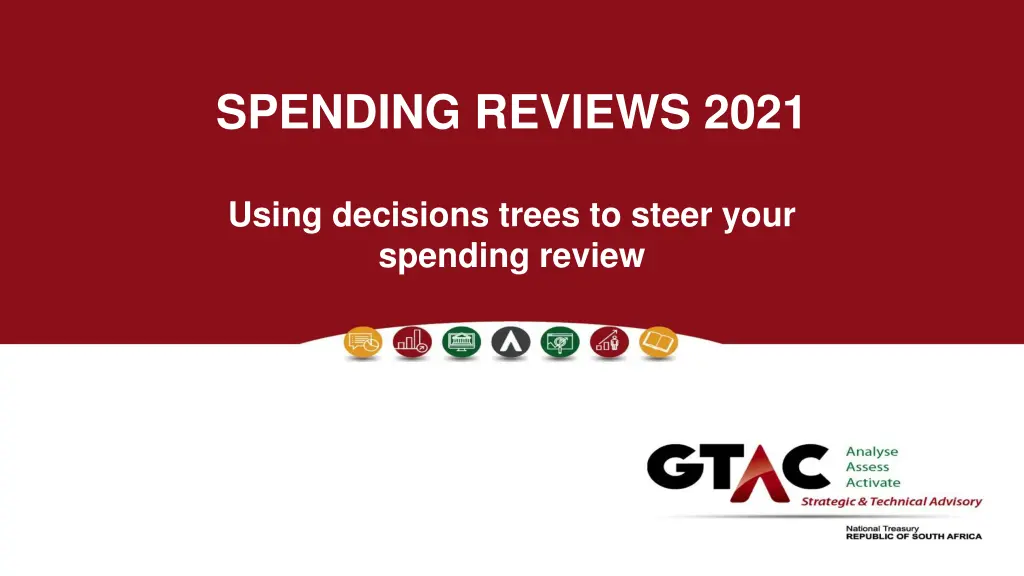
Harnessing Decision Trees for Effective Spending Reviews
Explore how decision trees can enhance your spending reviews by clarifying choices, assessing program effectiveness, and optimizing resource allocation. Learn how to use decision trees in analysis, evaluate public resource expenditure, and ensure program relevance and efficiency. Gain insights into institutional analysis, program evaluation, and cost modeling for informed decision-making.
Download Presentation

Please find below an Image/Link to download the presentation.
The content on the website is provided AS IS for your information and personal use only. It may not be sold, licensed, or shared on other websites without obtaining consent from the author. If you encounter any issues during the download, it is possible that the publisher has removed the file from their server.
You are allowed to download the files provided on this website for personal or commercial use, subject to the condition that they are used lawfully. All files are the property of their respective owners.
The content on the website is provided AS IS for your information and personal use only. It may not be sold, licensed, or shared on other websites without obtaining consent from the author.
E N D
Presentation Transcript
SPENDING REVIEWS 2021 Using decisions trees to steer your spending review
What will we cover today? 1 How can decision trees help you in your spending reviews? 2 How do you use decision trees in your analysis? 3 How decision trees help you to take action? 2
HOW CAN DECISION TREES HELP YOU IN YOUR SPENDING REVIEWS? 3
What are decision trees? Decisions trees help us clarify our choices when we need to make a decision. Most of us use them intuitively in our every day lives. Let s see how! Yes Yes Yes Should I buy these new shoes? Do I like the colour? Do I like the shape? Does it fit well? No No No Buy the shoes Yes Can I afford it? Don t buy the shoes No 4
Using the decision trees in a government programme 1 1 3 3 2 2 Assess whether the programme is still useful and relevant to the needs of beneficiaries Evaluate whether we are spending public resources economically Understand whether we are using the most efficient delivery models 5
How does the decision tree help you in a spending review? 2 2 3 3 1 1 Evaluate whether we are spending public resources economically Usefulness and Relevance of government programmes Understand whether we are using the most efficient delivery models Step 1: Institutional analysis Step 2: Logframes and business processes Step 3: Indicators/Performance analysis Step 4: Expenditure analysis Step 5: Cost modelling Step 1: Institutional analysis Step 2: Logframes and business processes Step 3: Indicators/Performance analysis Step 4: Expenditure analysis Step 5: Cost modelling Step 1: Institutional analysis Steps 5: Cost modelling 6
HOW DO YOU USE DECISION TREES IN YOUR ANALYSIS? 7
Decision tree Is there potential duplication with other programmes? Is the most cost- effective mix of personnel used to produce outputs? Are we buying goods and services at the best prices? Is the service still relevant to the needs of beneficiaries? Is the service still relevant to the needs of beneficiaries? Is government delivering the services efficiently and cost-effectively? Who should deliver these services? How best to deliver the service? Are we implementing the programme at the right pace? Are we using the right and affordable technology to deliver? Is the programme consistently overspending or underspending? 8
Relevance and appropriateness of delivery models Is the service a constitutional right? Deliver to entire population Who should deliver these services? Government is responsible for delivery Who within government must deliver the service? Who should receive the services? Is the service still relevant to the needs of beneficiaries? Yes Is the service a public or merit good? Delivered to a population subset/group Delivered to qualifying beneficiaries Private sector is responsible for delivery Is the service a mixed or private good? Close the programme Identify the department/entity responsible No Compare costed estimates Yes Has the inhouse delivery option been costed? In house delivery Prepare costed estimates How best to deliver the service? No Is the service delivered by the lowest cost provider? Yes Proceed to efficiency analysis Outsourced to the private sector Tender to find the lowest cost provider that meets quality standards Proceed to efficiency analysis Choose the most cost- effective approach No Choice of service delivery options should based on affordability, costs, quality and effectiveness What is the appropriate form of PPP? Contracted through a PPP Compare the benefits, risks and costs of different types of PPPs When assessing cost effectiveness, also look at whether the benefits outweigh the costs? Has the cost of service delivery by NPOs been costed? Yes Delivered by NPOs (through a subsidy) Prepare costed estimates No
Decision tree Is there potential duplication with other programmes? Is the most cost- effective mix of personnel used to produce outputs? Are we buying goods and services at the best prices? Is the service still relevant to the needs of beneficiaries? Is government delivering the services efficiently and cost-effectively? Who should deliver these services? How best to deliver the service? Are we implementing the programme at the right pace? Are we using the right and affordable technology to deliver? Is the programme consistently overspending or underspending? 10
Efficiency and cost-effectiveness analysis Downscale the programme to eliminate duplication Yes Is there potential duplication of functions with other programmes? Merge the programme with others to minimise duplication No Close the programme Keep the programme as it is. Change the grade of personnel to improve cost-efficiency Yes Yes Is government delivering the services efficiently and cost- effectively? Can you use lower grade personnel to deliver the service? Keep the programme as it is. No Is the most cost- effective mix of personnel used to produce outputs? Use fewer staff to improve cost- efficiency Yes Can you use fewer people to deliver the service? No Keep the programme as it is. No Manage overtime more tightly Yes Can you reduce the amount of overtime on this service? Keep the programme as it is. No Renegotiate contracts to reduce to the cost of goods and services Keep the programme as it is. Yes Are we buying goods and services at the best prices? Yes Can you negotiate better prices for goods and services? No Keep the programme as it is. No
Efficiency and cost-effectiveness analysis Keep the programme as it is. Accelerate the implementation of the programme Yes Are we implementing the programme at the right pace? Should government implement the programme at a faster pace? Yes Do the long term savings outweigh the short term costs? No Keep the programme as it is. No Should government slow the implementation of the programme? Slow down the implementation of the programme Do the short-term savings outweigh the long term costs? Yes No Keep the programme as it is. Is government delivering the services efficiently and cost-effectively? Keep the programme as it is. Are we using the right and affordable technology to deliver? Yes Introduce new technology Is the new technology affordable to set up and maintain over the long term? Yes Yes No Is new technology more cost effective than traditional one used? Revise the specifications for the technology or scope of the project No Keep the programme as it is. No Keep the programme as it is. Amend the budget to reflect the true cost of the programme Investigate the root cause of over/underspending Based on the root cause Is the programme consistently overspending or underspending? Yes Create performance- based allocations No Change the conditional grant framework Do nothing 12
HOW DECISION TREES CAN HELP YOU TO TAKE ACTION? 13
Actioning findings from spending review Having considered the range of intervention choices using the decision trees, now consider the actions you can take as a Treasury official. There are a range of PFM reforms that NT needs to pursue that are not linked to a specific programme, like revising the SCM regulations, or ensuring better design of budget programmes and revising the virement regulations. But, there are also programme-specific actions which may be required to improve the efficiency and cost-effectiveness of the programme. 14
Improvements/reforms that emerge from spending reviews MTEF MTEF Year 1 Year 1 Year 2 Year 2 Year 3 Year 3 Process changes and improvements Institutional streamlining Personnel optimisation Policy and legislative changes 15
Policy and legislative changes Actioning findings from spending reviews Spending review finding: The target group of beneficiaries needs to be defined in more detail. What can Treasury do? - Work with departments to influence the scope of the programme and qualifying criteria for beneficiaries What can the line Department do? Revise the policy framework and eligibility criteria Stakeholders National & provincial line departments Forecast demand for programme - Structure the equitable sharing process to emphasise particular services/groups of beneficiaries Prepare costed estimates of implementation - Change the conditional grant work Issue guidelines or directives Revise templates, reporting requirements and M&E 16
Policy and legislative changes Actioning findings from spending reviews Spending review finding: Government is delivering a service that should be delivered by the private sector. What can Treasury do? - Defund the goods and services component of the programme What can the line Department do? Redeploy personnel Stakeholders National & provincial line departments Retrench personnel - Phase out funding for the programme over time DPSA - Allocate funding for retrenchments - Close the programme 17
Actioning findings from spending reviews Process changes and improvements Institutional streamlining Spending review finding: The delivery model is not appropriate and might not offer value for money. What can Treasury do? - Work with the department to find the most cost- effective delivery approach What can the line Department do? Prepare costed estimates of implementation of most suitable delivery model Stakeholders National & provincial line departments - Allocate budget based on costed estimates of the rollout Address impact on personnel based on the delivery option chosen DPSA 18
Institutional streamlining Actioning findings from spending reviews Personnel optimisation Spending review finding: There is duplication of functions across programmes or entities. What can Treasury do? - Freeze all new positions on programmes where there might be duplication What can the line Department do? Establish a cross-entity task team to map out functions and identify the scale and scope of duplications Stakeholders National & provincial line departments - Get DPSA to review the post establishment of the entity Scale back programme to minimise duplications - Defund the goods and services component of the budget Merge or consolidate entities - Highlight the specific function duplications and require entities to consolidate or eliminate duplication Shut down entities or programmes that duplicate functions 19
Actioning findings from spending reviews Personnel optimisation Spending review finding: The programme or service is costly because personnel resources are not utilised efficiently. What can Treasury do? Reduce personnel budgets What can the line Department do? Redeploy personnel Stakeholders National & provincial line departments Make funding available for retrenchment Get involved in public service salary negotiations Change the quantity and grade of personnel who deliver the service DPSA Do proper analyses regarding moves to expand the public service (e.g. making community health workers public servants) Retrench personnel 20
Actioning findings from spending reviews Process changes and improvements Spending review finding:Goods and services purchased are costly. What can Treasury do? Develop a transversal contract for certain categories of bulk purchases What can the line Department do? Prepare costed estimates of implementation of most suitable delivery model Stakeholders National & provincial line departments Set price benchmarks (min-max range for categories of commonly purchased goods) Address impact on personnel based on the delivery option chosen Monitor average unit prices of items purchased by government and compare to private sector prices Change SCM regulations (especially to promote greater accountability) 21
Actioning findings from spending reviews Process changes and improvements Spending review finding: There is not enough information to understand expenditure or assess efficiency. What can Treasury do? - Reform the budget structure to improve how expenditure is reported - Review whether the Item segment reflects items used in the programme appropriately - Explore how the Responsibility and Project segments in BAS might be used to track spending - Explore how PERSAL might be used to track personnel spending better. - Put in place specific reporting requirements for specific kinds of expenditure or specific programmes - Revise the reporting responsibilities on conditional grants What can the line Department do? - Improve reporting capacity Stakeholders - National & provincial line departments - Work with NT to use BAS segments and PERSAL more effectively 22
Actioning findings from spending reviews Process changes and improvements Personnel optimisation Spending review finding:There are opportunities to digitize the delivery of public services to save money. What can Treasury do? - Make provision for capital costs involved in digitisation What can the line Department do? Develop and cost a digitisation plan and platform migration Stakeholders National & provincial line departments - Cut budgets over time as digitisation is phased in Work out the personnel and other implications of digitisation DPSA Change the department establishment to reflect the changes to the programme 23
Actioning findings from spending reviews Spending review finding: There is consistent under/overspending on a programme. What can Treasury do? Allocate the budget based on the true cost of the programme after taking into account affordability What can the line Department do? Prepare costed estimates of implementation Stakeholders National & provincial line departments Link budget allocations to performance Make the budget allocation exclusive and specific (i.e. the funds may not be used for anything else prevents virement) Revise virement regulations and conditions Revise the conditions on conditional grants 24
GTAC Government Technical Advisory Centre Private Bag X115 Pretoria 0001 GTAC Government Technical Advisory Centre 240 Madiba Street Pretoria 0002 info@gtac.gov.za www.gtac.gov.za 25


